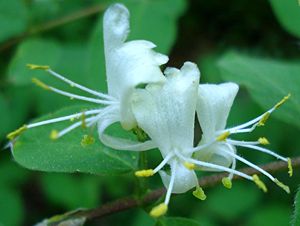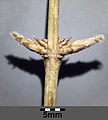Red honeysuckle
| Red honeysuckle | ||||||||||||
|---|---|---|---|---|---|---|---|---|---|---|---|---|

Red honeysuckle ( Lonicera xylosteum ) |
||||||||||||
| Systematics | ||||||||||||
|
||||||||||||
| Scientific name | ||||||||||||
| Lonicera xylosteum | ||||||||||||
| L. |
The red honeysuckle or common honeysuckle ( Lonicera xylosteum ) is a species of the honeysuckle family (Caprifoliaceae). The shiny red berries are inedible and poisonous for humans due to the bitter substance xylostein . The shrub owes its nickname xylosteum to its bone-like wood, from the Greek xylos 'wood' and osteon 'bone'.
description
The red honeysuckle is a deciduous shrub that reaches heights of about 1 to 2 meters. It has hollow branches. The elliptical leaves are pubescent on the top and bottom.
The yellowish white single flowers stand in pairs on a common stem. The two ovaries of each flower pair are only fused together at the base. It blooms in May and June. The berry fruits, which are poisonous for humans, are strikingly red in color.
The chromosome number of the species is 2n = 18.
ecology
The red honeysuckle is a shallow root. Its flowers are used by hymenoptera such as B. pollinated by wood bumblebees . The berry fruits either spread by themselves ( autochory ) or, in order to germinate properly, they have to pass through the intestinal tract of some animals ( endozoochory ). The seeds contained in the berries also need cold to germinate. The species is resistant to de-icing salts and is not bitten by game.
Occurrence
The red honeysuckle is relatively widespread in almost all of Germany as well as in Europe and Asia. In Asia it occurs in Turkey and Siberia. It often occurs in herbaceous oak and beech forests, also in elm, linden or mixed conifer forests, in hedges and in bushes, also planted at roadsides. It prefers nutrient-rich, chalky soil in shady or partially shaded areas. In the Allgäu Alps, it rises in the Tyrolean part below the Plattig between Holzgau and Jöchelspitze up to 1400 m above sea level.
According to Ellenberg , it is a penumbra plant, distributed sub-oceanic, a freshness pointer, a weak acid to weak base pointer and a class character of the summer deciduous forests and bushes (Querco-Fagetea).
use
The species is planted again and again during greening measures.
In earlier times the plant was sometimes used as a "white" spider rice to bind brooms . The more commonly used "black" spider rice comes from Betula pendula .
Ingredients and toxicity
In the plant are Xylostein , Xylostosidin , saponins and cyanogenic glycosides found.
Poison control centers are often consulted about the red fruits, although recent studies have shown that they are only slightly poisonous. Symptoms can occur after consuming about 5 fruits. The effect is due to saponins rather than alkaloids .
literature
- Erich Oberdorfer : Plant-sociological excursion flora for Germany and neighboring areas . With the collaboration of Angelika Schwabe and Theo Müller. 8th, heavily revised and expanded edition. Eugen Ulmer, Stuttgart (Hohenheim) 2001, ISBN 3-8001-3131-5 .
- Margot Spohn, Marianne Golte-Bechtle: What is blooming there? The encyclopedia: over 1000 flowering plants from Central Europe. Kosmos, Stuttgart 2005, ISBN 3-440-10326-9 .
- Peter Schütt, Horst Weisgerber, Hans J. Schuck, Ulla Lang, Bernd Stimm, Andreas Roloff: Encyclopedia of Deciduous Trees . Nikol, Hamburg 2006, ISBN 3-937872-39-6 .
- Siegmund Seybold (Ed.): Schmeil-Fitschen. Interactive flora of Germany. Seeing - determining - knowing. The key to the flora . CD-ROM, version 2.0. Quelle & Meyer, Wiebelsheim 2004, ISBN 3-494-01368-3 .
- Michael Wink, Ben-Erik van Wyk, Coralie Wink: Handbook of poisonous and psychoactive plants. Wissenschaftliche Verlagsgesellschaft, Stuttgart 2008, ISBN 978-3-8047-2425-9 .
Individual evidence
- ^ Erich Oberdorfer : Plant-sociological excursion flora for Germany and neighboring areas . 8th edition. Stuttgart, Verlag Eugen Ulmer, 2001. Page 877. ISBN 3-8001-3131-5
- ^ Lonicera in the Germplasm Resources Information Network (GRIN), USDA , ARS , National Genetic Resources Program. National Germplasm Resources Laboratory, Beltsville, Maryland. Retrieved April 20, 2018.
- ↑ Erhard Dörr, Wolfgang Lippert : Flora of the Allgäu and its surroundings. Volume 2, IHW, Eching 2004, ISBN 3-930167-61-1 , p. 522.
- ↑ Heinz Ellenberg : Vegetation of Central Europe with the Alps in an ecological, dynamic and historical perspective (= UTB for science. Large series . Volume 8104 ). 5th, heavily changed and improved edition. Eugen Ulmer, Stuttgart (Hohenheim) 1996, ISBN 3-8252-8104-3 .
- ^ Hermann Fischer: Swabian dictionary . Due to the Adelbert v. Keller started collections and with the support of the Württemberg state. First volume. ABP H. Lauck'sche Buchhandlung, Tübingen 1904, column 914 (online) .
photos
Web links
- Red honeysuckle. In: FloraWeb.de.
- Red honeysuckle . In: BiolFlor, the database of biological-ecological characteristics of the flora of Germany.
- Profile and distribution map for Bavaria . In: Botanical Information Hub of Bavaria .
- Lonicera xylosteum L. In: Info Flora , the national data and information center for Swiss flora .
- Distribution in the northern hemisphere from: Eric Hultén, Magnus Fries: Atlas of North European vascular plants. 1986, ISBN 3-87429-263-0 at Den virtuella floran (swed.)
- Thomas Meyer: Honeysuckle data sheet with identification key and photos at Flora-de: Flora von Deutschland (old name of the website: Flowers in Swabia )






